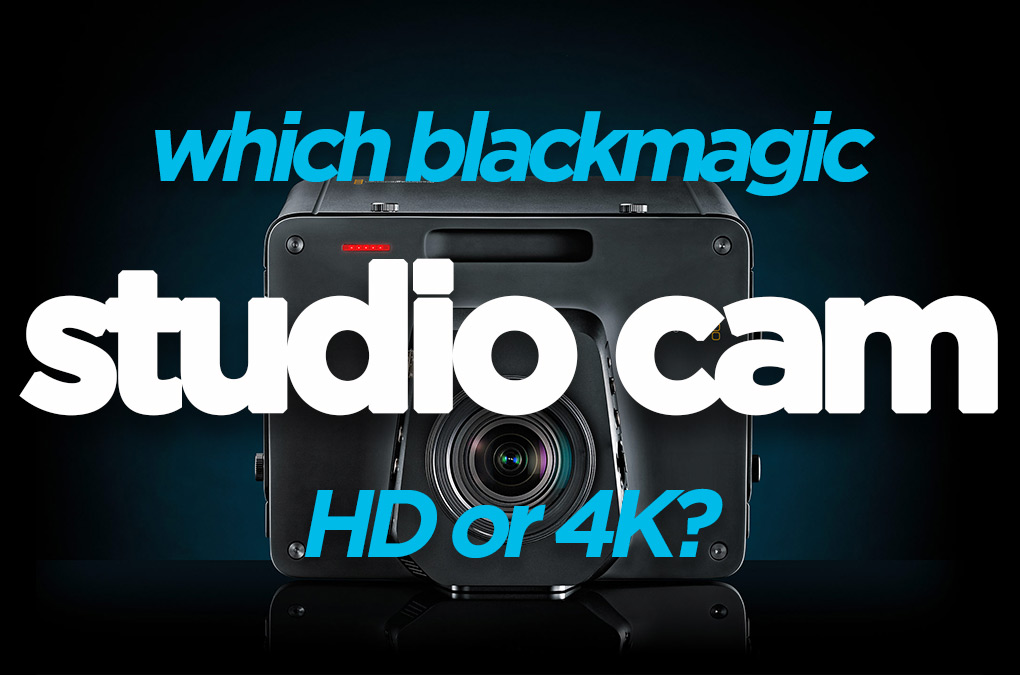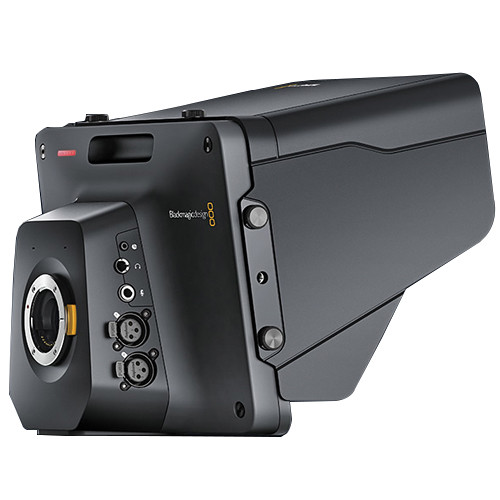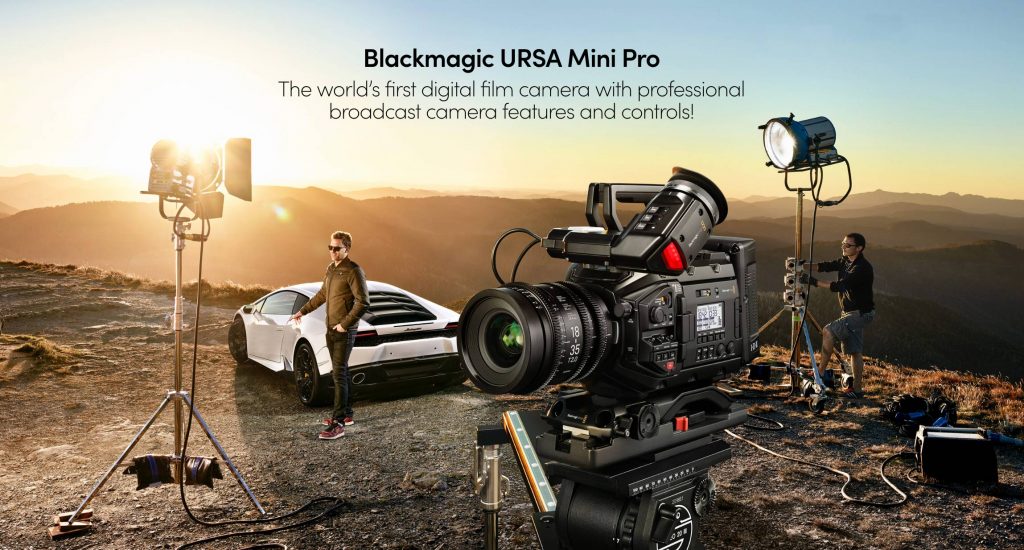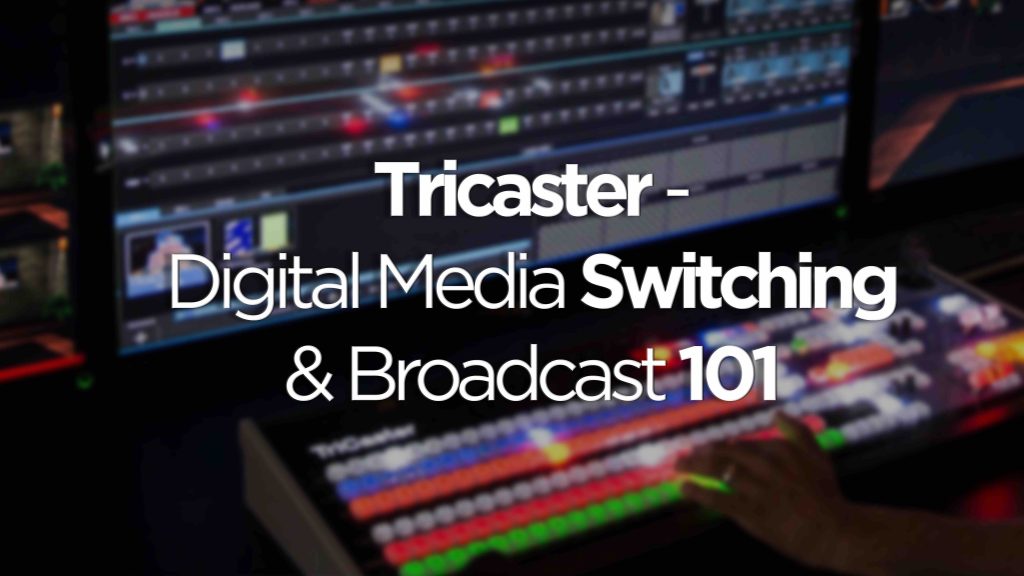HD or 4K? That’s the question when it comes to the Blackmagic Studio Cameras
Choosing between HD and 4K, at this time in digital video production, is a hard question to answer, and a lot of the time it does come down to available budget.
However, something to keep in mind when making this decision is also the delivery destination.
If you are working in TV broadcast then you probably will be looking down the line of 4K but if you work within web content and specifically social media content, then HD is plenty.
The reason I say this is because, for social media content (such as YouTube pundit shows that I’ve worked for a number of years on), the platforms cannot deliver more than HD reliably anyway. It is only if you are viewing on a desktop or on a very reliable internet connection, that are you going to get the optimal viewing experience of greater than HD. For platforms such as Twitter and Instagram, I believe we are a few yeras away from 4K being the dominant form of video on those platforms over mobile reception.
So, as you can see, there is still a clear need for HD and going down the route of 4K doens’t necessarily mean your final produciton will be seen in that quality anyway.
How do I know what I’m talking about? Head to the DigiProTips Experience and Background page to find out how I’ve built up my knowledge over a career spanning feature film, broadcast TV and digital content production.
DISCLAIMER: This post may contain affiliate links. We make a small commission if you buy the products from these links (at no extra cost to you). As an Amazon Associate, I earn from qualifying purchases. But we only recommend products we would use ourselves. For more information, click here to see our disclosures.
Example Costs
HD Route
| Item | Quantity | Price |
| Studio Camera HD | x3 | $4,485 |
| ATEM Television Studio Pro HD Switcher | x1 | $2,295 |
| 20m 3G SDI Cable | x3 | $135 |
| Total | $6,915 |
4K Route
| Item | Quantity | Price |
| Studio Camera 4K | x3 | $5,085 |
| ATEM Television Studio Pro 4K Switcher | x1 | $2,475 |
| 20m 12G SDI Cable | x3 | $252 |
| Total | $7,812 |
Why Blackmagic Design?
If you’re reading this article then I am guessing by this point you’re already fairly sure you will be going down the road with a Blackmagic Studio Camera of some sort. This leads me to believe you know of and/or have used Blackmagic Design products in the past.
However, if you haven’t and have searched for high-quality studio cameras that don’t break the bank then your search may very well have lead to this page. On that basis, it’s worth me giving a little background to Blackmagic and why I recommend them for studio productions.
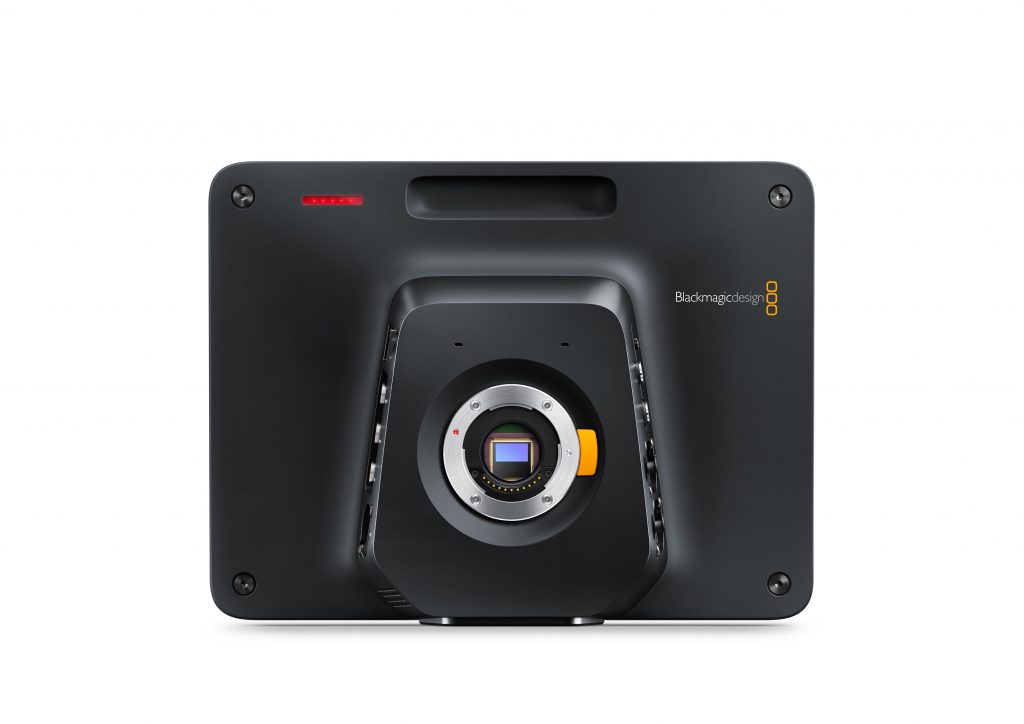
Blackmagic Design in recent years has become known and has cornered a market share, for mid to top-end level products for digital video production. It’s the mid-end that has real appeal. Not only are their products of superb build quality but the results from them are up there with some of the highest level cameras and studio tech that you can get… but for a fraction of the price.
Blackmagic Design is usually one of the first to market with higher specification hardware than their competitors and they come with fantastic in-house software and utilities to use them with too. An example being the URSA Mini Pro. Back in 2017, I ordered two of the 4K models, as they were one of the best looking 4K cameras for their price anywhere. Now, they are coming out with 12K cameras with their own RAW codec combined with amazing color integration with DaVinci Resolve. In terms of software, DaVinci Resolve is now an all-encompassing NLE capable of audio, VFX, edit and grading all in one piece of software.
Basically, Blackmagic Design is building its own ecosystem for digital video and studio production. If you work within it, you can not only beat prices from around the market but you can get quality to match top-level setups as well.
ATEM & DaVinci Resolve
Because Blackmagic Design has got this ecosystem in place, it means you can take advantage of some brilliant workflows within it.
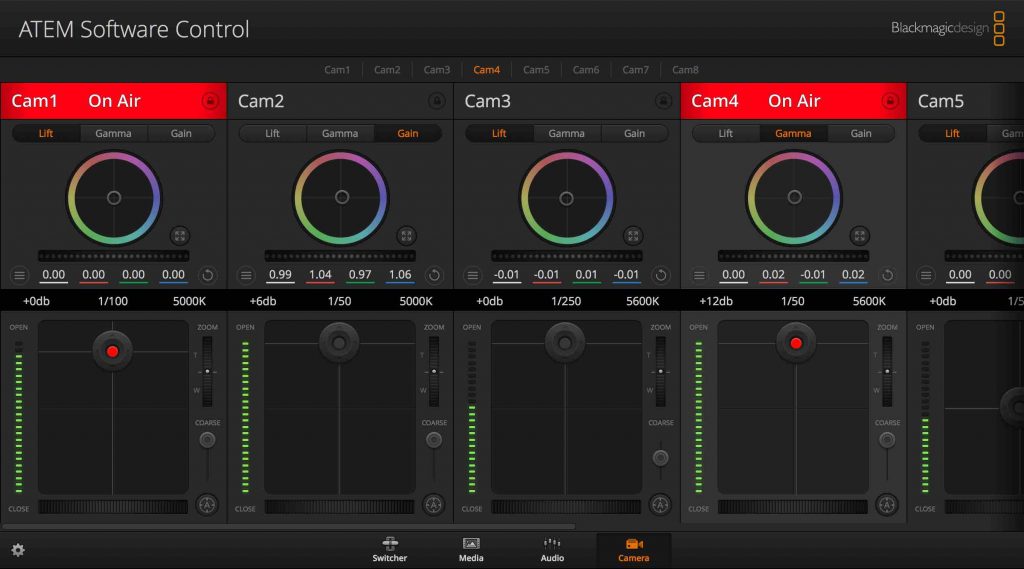
For example, by using one of the ATEM switching desks (check out my guide to the ATEM Mini here) you can access the ATEM Camera Control software to adjust and control your cameras focus, aperture and colour correction tools… all from your control gallery. That means all your cameras will be perfectly balanced on set, without you needing to do any post-production to match cameras in the edit.
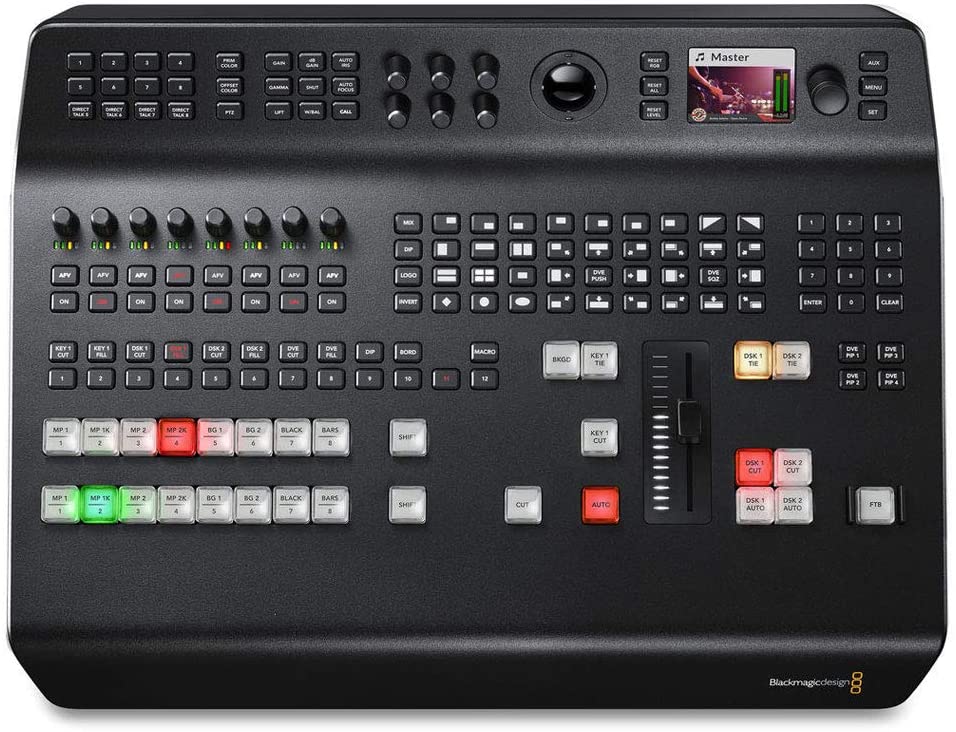
The integration with DaVinci Resolve is also another fantastic feature. If you are using the ATEM range of switchers then you can have your production save a synced up multicam sequence to edit and tweak in Resolve, straight after you finish recording. No ingesting and messing around trying to line everything up. It’s there, ready for you, with all the cut points you made in the live program.
For me, creating YouTube shows and long-form content of any sort. Having to correct cameras in post and having to sync up up rushes to create my multicam sequence could take up a significant amount of time. With these taken care, of on set, you have much more time to play with at the other end in post-production. Meaning you can deliver quicker or have more time for creative flair.
That’s working smarter and not harder.
Features of the Blackmagic Studio Cameras
Design
It’s hard to talk about the Blackmagic Design Camera without mentioning its design.
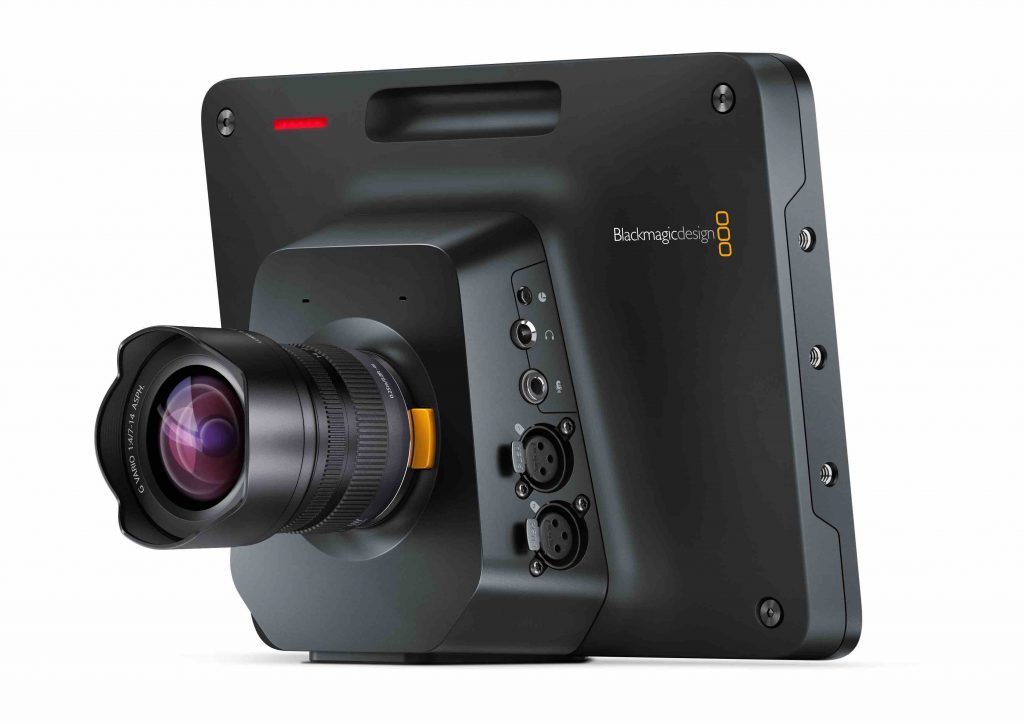
When I first came across the camera I was a little confused by it but as soon as you use it you understand it completely and come to love the massive 10″ viewfinder. It makes looking at smaller 5″ monitors and DLSR screens very difficult after the detail you get with this camera.

For beginners looking at this camera, you should know that this is purely an on-set studio camera. It has no recording functionality of its own. However, if you are looking for a camera that can double as a film and studio camera then the aforementioned URSA range is a great camera for this purpose.
Lenses
The next very obvious thing to note about this particular camera is the lens mount type. It’s a micro-four-thirds lens mount (MFT).
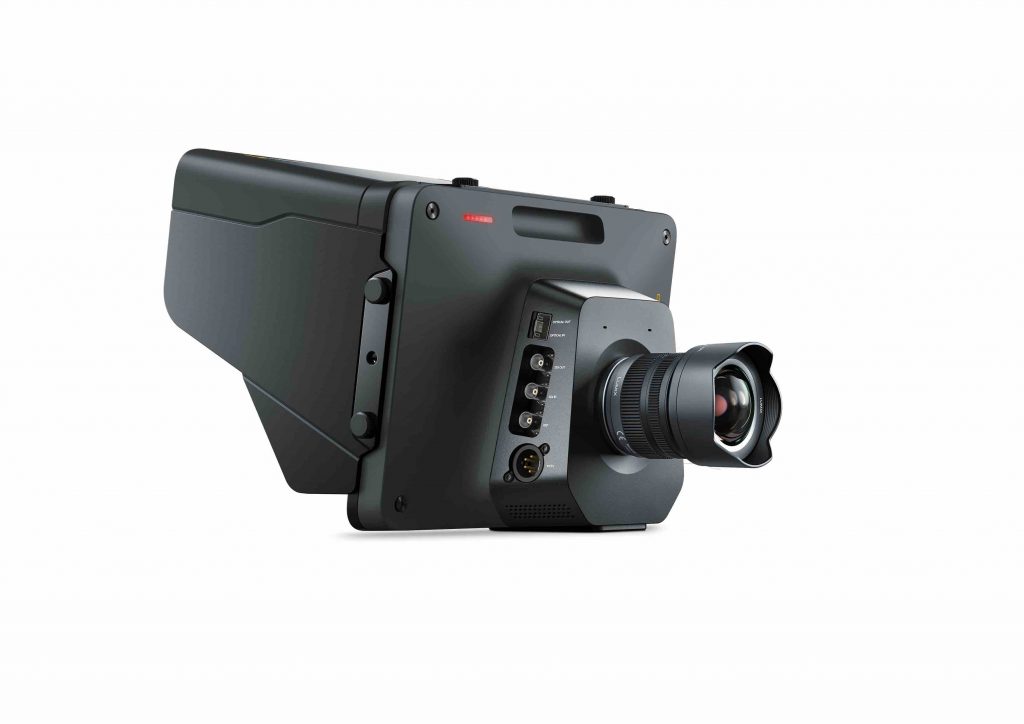
This is a lens mount that’s very common to find in mid-range DSLR’s these days rather than studio cameras. However, this is where Blackmagic are working that market domination. By using MFT over studio broadcast ENG mounts they can appeal to a wider customer base and capitalize on the digital video professionals who already own MFT lenses and want to move their production level up a notch.
When I got working with the Blackmagic Studio Camera in 2017 I was a little bit lost for lens choice. You see, I ideally wanted to have ATEM Camera Control over the focus and aperture, however, you need to ensure you have motorized MFT lenses for this and most of my lenses were Canon EF lenses without the ability to be externally controlled, even with Metabones adapters.
These days, there are quite a few options to choose from, and if you aren’t worried about controlling your camera’s focus or aperture from the gallery/control room because you have camerapeople on the studio floor then by having an MFT mount you potentially have the option to work with any lens you choose. Even film PL mount lenses can be used with the correct adapter in place.
It could be seen as a flaw by some but to me it’s a very clever move on Blackmagic’s part because they haven’t chosen sides over the lens mount for say Sony, Nikon, or Canon and instead have gone neutral with MFT and opened up the floor for their product to be used with an abundance of lenses from any manufacturer.
For more on the best lenses for this camera, check out the article right here:

Connections
The last feature of the cameras themselves that I want to mention is the plethora of connections you have available to you.
These cameras are not just a viewfinder with an SDI out and that’s it. No, no. They are jam-packed full of inputs and outputs to use between the studio floor and the gallery. Take a look for yourself:
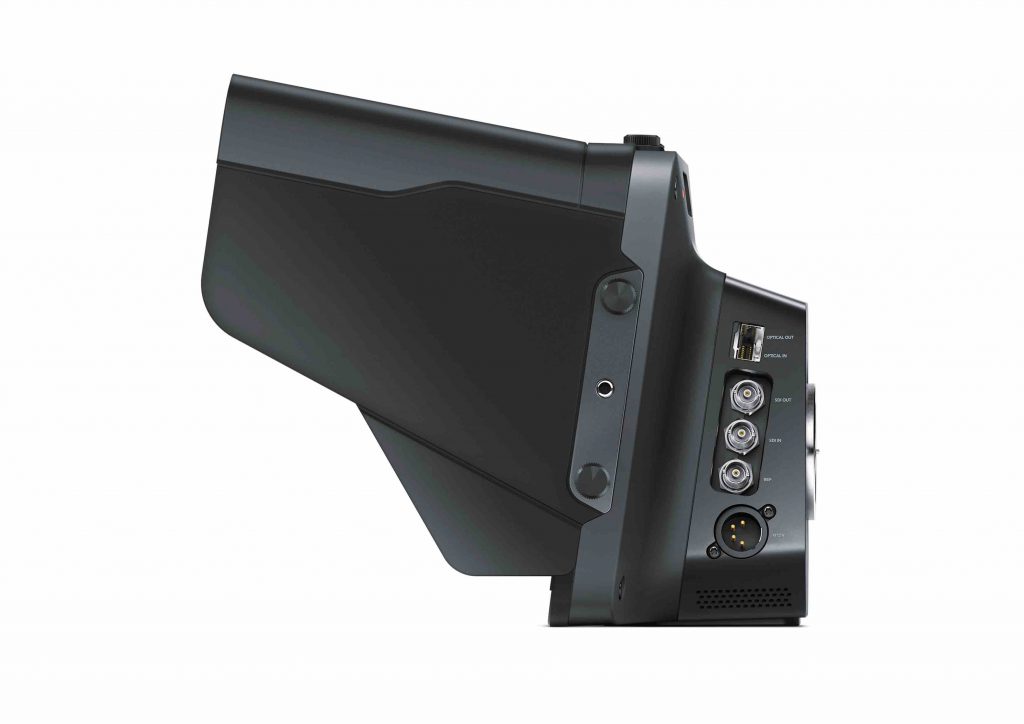
With the SDI return feed, you get a program feed to your cameraperson but you also enable tally. So your cameraperson and the talent on set know which camera is live at any given point in time.
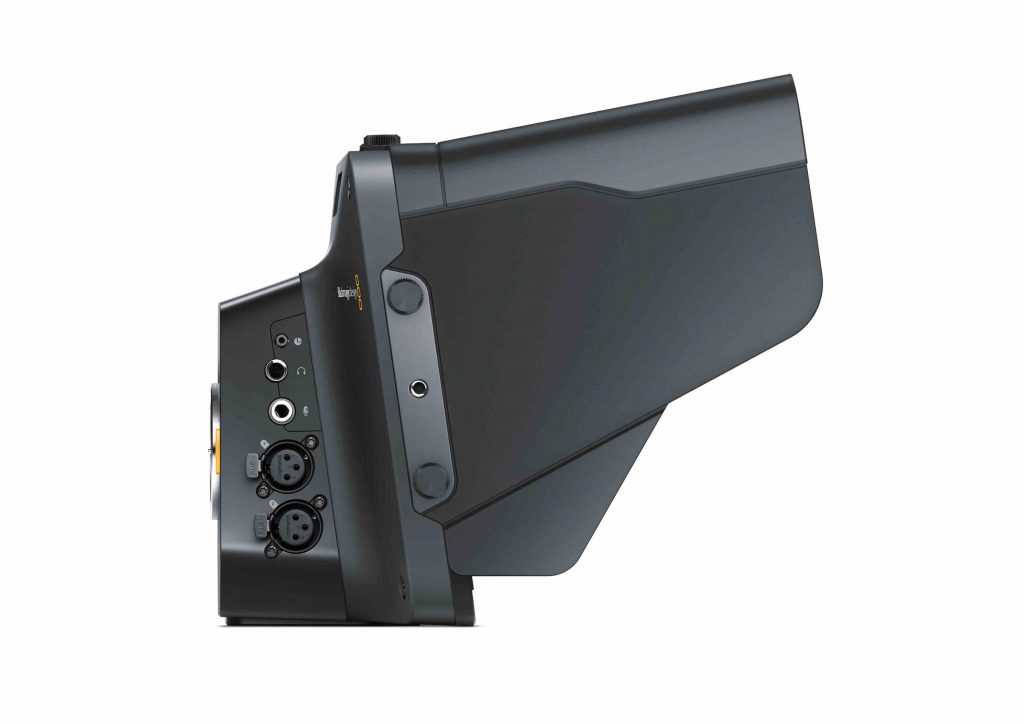
With audio in and out, via a combination of 3.5mm and 6.35mm jacks (aviation headsets), you also get talkback. That means your camerapeople can talk to the director/producer of the program and vice versa to get that perfect close up or to fix an issue with the camera on set.
Which SDI Cable do I Need For 4K?
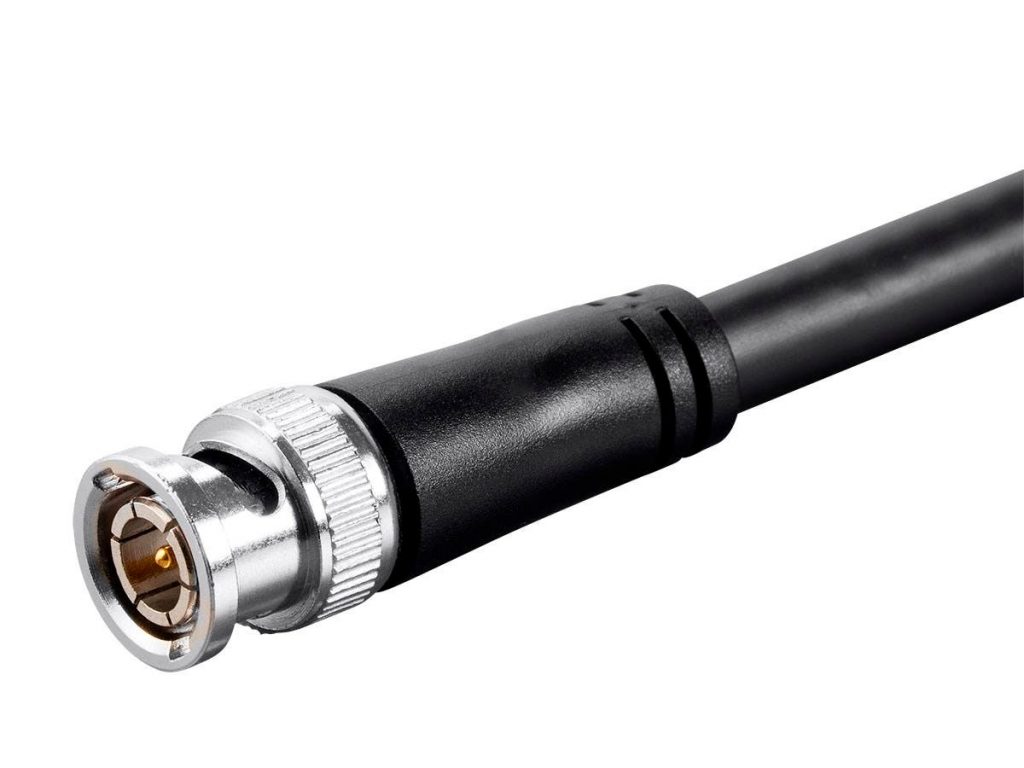
Now, when it comes to choosing your camera you also need to pay attention to your cabling as well.
That’s because not all SDI cables are created equally.
As you may have noticed in my example costs above, there is a difference in the name and also in the price.
HD SDI cables are pretty much everywhere these days and you can run HD footage down HD-SDI cables no problem, for up to 30fps. If you want higher framerate footage then you need to be looking at 3G-SDI, which will accommodate HD footage up to 60fps.
You see, it’s all about the bandwidth, the data rate that these cables can carry. It’s safe to assume that the smaller the G number the less data that cable type can carry. This is mainly because it is an older cable type, made when video sizes were much smaller. The G number is relative to the Gbps that it can support. So a 3G-SDI cable supports around 2.97Gbps bitrate. 12G-SDI supports up to 12Gbps.
When working with the 4K camera and recording 4K footage via SDI cable you need to be using at least 6G-SDI. This is your base standard for SDI in the 4K environment. 6G-SDI can support 2160p30 video. For 60fps you need to be looking at 12G-SDI.
There is now a 24G-SDI cable that can carry 2160p/4k@120 or 8k@60 but for our purposes, with the Blackmagic Studio Cameras, we’re not going to need that sort of bandwidth.
The costs associated with SDI go up in price, per metre, as the G number increases. You can expect to pay nearly twice the price for 12G as opposed to 3G cable.
So choosing HD or 4K has implications across the board, not just the camera you decide to go with. It’s the switcher, cabling, and even your network capabilities too if you want to edit 4K over your network in post-production. You can read more about that here:
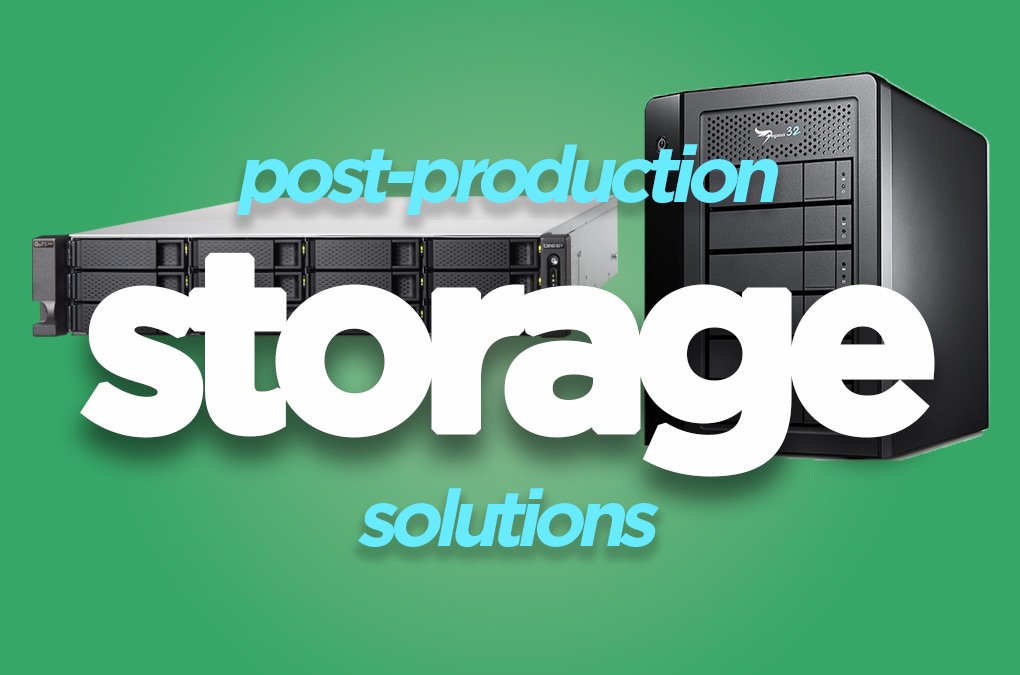
Results
I have used many varieties of cameras in studio setups for live streaming and recording long-form programming before. I have had a variety of mixed results when working with both SDI, HDMI, and NDI (as you may have noticed, I like to champion NDI though). It used to be that to get the best results you were still better off recording to card and syncing in post, unless you were working from very high-quality setups.
With the Blackmagic Design Cameras that all changed in an instant.
The most noticeable change of all was the dynamic range in color. It was bursting out of the screen when compared to studio cams I had worked with in the past.
Not only that but everything was sharper, I wasn’t even using new lenses. The sensors in these cameras are something wicked. If anything, at times it could be a little too sharp.
The image quality of these cameras should not be overlooked when checking your budget requirements. I really was instantly impressed when I saw the visual improvement from what I had been working with in the past. For the price point, I think it’s the best your money can get without investing in extremely high-end studio broadcast-grade cameras.
So, Which Blackmagic Studio Camera to Get, HD or 4K?
Now you have some of the background to these cameras and the setups involved for HD and 4K workflows you should have more than enough information to make that decision.
Blackmagic Studio Camera HD – The perfect camera for social longform content
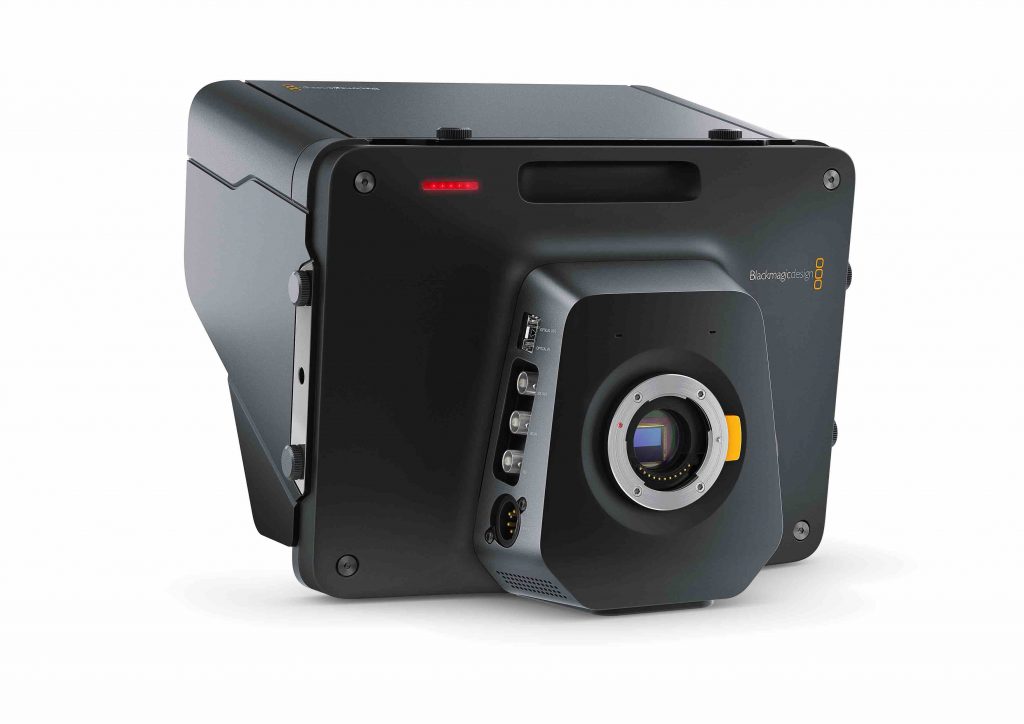
This is the camera for you if you are delivering to social media platforms, as I was a few years back.
Like I said above, we are still a few years off 4K social video being the norm and when it comes to streaming we’re even further back in the queue with some services only delivering in 720p (not many though I will grant you). 4K for live streaming is more costly than it is worth for the end product at this point in time. I would save the money on the infrastructure set up costs and put that into glass, better lenses, for the HD version of this camera.
With the results that I mentioned above, you will be checking your eyesight to make sure you’re seeing right with the sharpness and detail you get anyway. 4K is always a nice addition at this level but in this bracket, it’s definitely not necessary.
The version 02 of the Blackmagic Studio Camera HD retails for around $1,495.
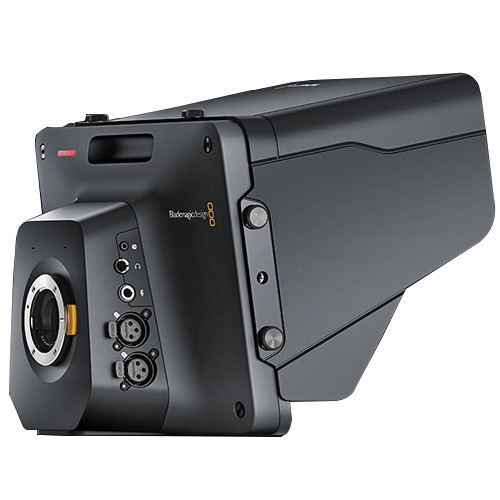
Blackmagic Studio Camera, the world’s most advanced broadcast camera for live production! Inside its incredibly tough, lightweight magnesium alloy body you get a massive 10” viewfinder, talkback, remote camera control, tally indicators, phantom powered microphone connections, and SDI or user installable optical fiber connections that let you connect to your switcher with a single cable!
Blackmagic Studio Camera 4K – The perfect camera for studio broadcast

Now, if you have the budget or if you’re in a broadcast studio environment, then I can only recommend your investment to increase slightly and reach for the 4K.
Why?
Because broadcast is already at 4K level. To go down the HD route now would not be a wise move. You’ll end up upgrading your equipment in a year or two when all your competitors are broadcasting in 4K regularly.
Get ahead of, or be at the same level of your competitors right now and broadcast in 4K.
The extra detail, resolution, and options for re-framing in post-production are worth the extra investment at this level.
Yes, you will need to invest in the hardware mentioned above for 4K as well as the camera but the results will speak for themselves when you do.
Once you have decided on the 4K camera it would be my recommendation you also look to upgrade your post-production set up to 4K workflows too. That means investing in 10Gigabit network speeds and storage. The article I listed above and here can help you with that.
Version 02 of the Blackmagic Studio Camera 4K retails for around $1,695.
Happy Shooting
Now that you have all the information you need to make an informed decision it’s down to you to make that choice.
For me, I’m quite excited that more of you will be using these cameras and getting to work with studio-quality technology, at a fraction of the high-end studio prices.
Enjoy the process, I know I did!
DigiProTips

